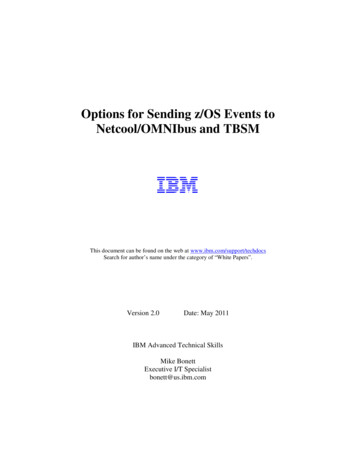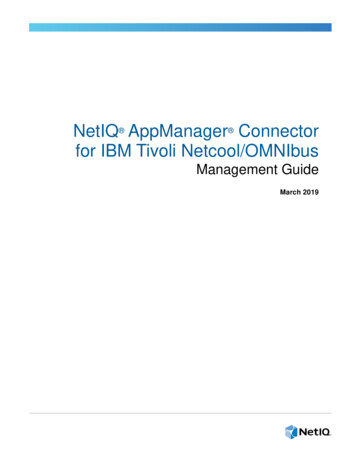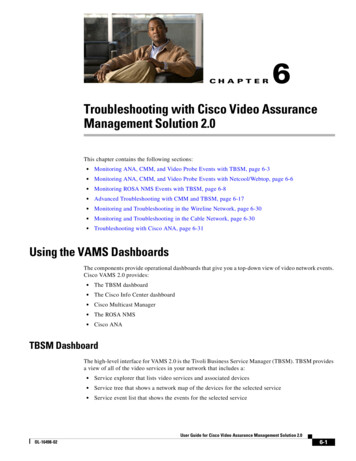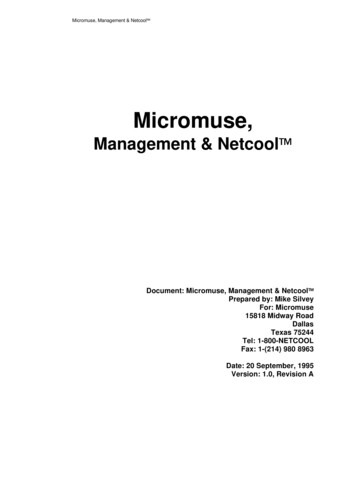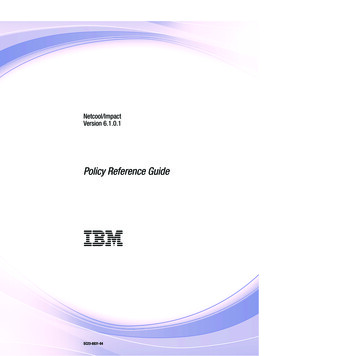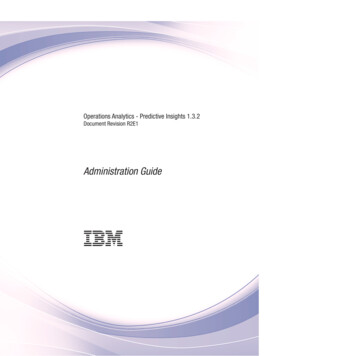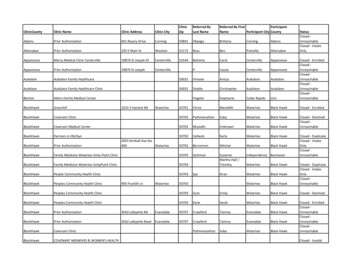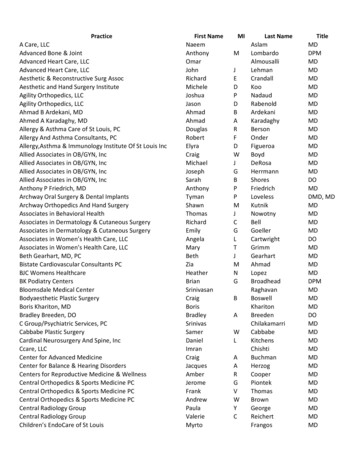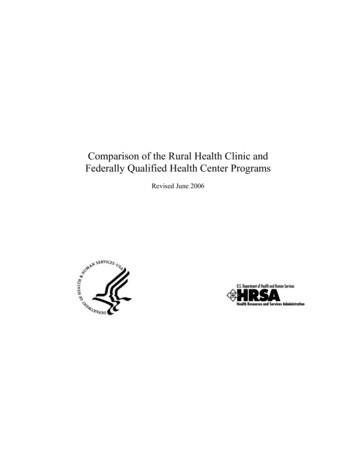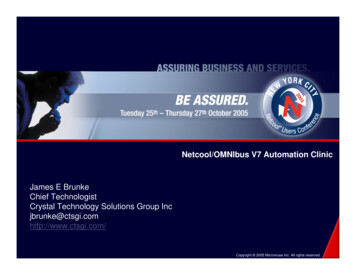
Transcription
Netcool/OMNIbus V7 Automation ClinicJames E BrunkeChief TechnologistCrystal Technology Solutions Group Incjbrunke@ctsgi.comhttp://www.ctsgi.com/Copyright 2005 Micromuse Inc. All rights reserved.
Welcome Brief overview of Procedural SQL specific to automations Explanation of different Automation Trigger types Calculating Duration Deduplication Clearing “X in Y” Event Escalation Lots of code to take home and try (YMMV)Copyright 2005 Micromuse Inc. All rights reserved.2
Procedural SQL INSERT, UPDATE, DELETE WRITE INFO (CREATE FILE) ALTER (TRIGGER, SYSTEM) RAISE SIGNAL EXECUTE, CALL Programming constructs (SET, IF THEN ELSE, CASE WHEN, FOR EACHROW, FOR, BREAK, CANCEL) Functions – old ones (getdate), lots of new ones (substr, to time )Copyright 2005 Micromuse Inc. All rights reserved.3
Procedural SQL (cont) User Variables (%user.user id, %user.user name, %user.app name ) Trigger Variables (%trigger.xxxxx) Operators (added % and %! to ignore case, % , % , % , % alphabetic order) No SELECT inside trigger (Evaluate clause)Copyright 2005 Micromuse Inc. All rights reserved.4
Trigger Types Temporal Signal Database (woo-hoo!!!)Copyright 2005 Micromuse Inc. All rights reserved.5
Temporal Triggers Operate fundamentally the same as in Omnibus 3.x Priority indicates what order to run (previously in alpha order) Indicate how often to run (every xx seconds, minutes, etc) Evaluate contains SELECT statement if procedure is to operate usingdata from a specific set of rows (FOR EACH ROW) You can’t specify ORDER BY in SELECTCopyright 2005 Micromuse Inc. All rights reserved.6
Signal Triggers Trigger fires when signal received System triggers include things like startup, shutdown, client(dis)connection, logins, backups, etc) Can also create user triggers which can be kicked off with RAISE SIGNALstatement Variables are defined (%signal.xxxx) which contain attributes specific tothe signal trigger raiseCopyright 2005 Micromuse Inc. All rights reserved.7
Database Triggers Without question, the most powerful addition made in V7 (IMHO) Trigger will fire when either before or after a modification (insert, update,delete, reinsert) is attempted to an ObjectServer table Trigger can fire for every row modified or just once for the specific SQLstatement executed If WHEN clause is specified, trigger will only fire when condition is true CANCEL statement in the procedure section stops operation fromoccurring in a before database trigger No Evaluate clause old. and new. VariablesCopyright 2005 Micromuse Inc. All rights reserved.8
Database Triggers (cont)OperationTimingnew. field Available?new. field Modifiable?old. field Available?old. field EYesNoYesYesREINSERTAFTERYesNoNoNoCopyright 2005 Micromuse Inc. All rights reserved.9
Duration Calculation Concept presented at the 2004 NUC in session “Using Netcool To CreateAvailability Reports” Use Generic Clear to calculate amount of time between Problem andResolution events LastCleared field in Problem event will contain date/time stampindicating when it was cleared Duration field will contain “rolled up” time in seconds that the Problemlasted Handles deduplicationCopyright 2005 Micromuse Inc. All rights reserved.10
Duration Calculation prerequistesalerts.problem events2NameData TypeLengthPrimary eger4Copyright 2005 Micromuse Inc. All rights reserved.11
Trigger generic clear-- Populate a table with Type 1 events corresponding to anyuncleared Type 2 eventsfor each row problem in alerts.status where problem.Type 1and problem.Severity 0 and (problem.Node problem.AlertKey problem.AlertGroup problem.Manager)in ( select Node AlertKey AlertGroup Manager fromalerts.status where Severity 0 and Type 2 )begininsert into alerts.problem events2 values(problem.Identifier, problem.LastOccurrence,problem.AlertKey, problem.AlertGroup, problem.Node,problem.Manager, false, problem.ClearedTime,problem.Duration );end;Copyright 2005 Micromuse Inc. All rights reserved.12
Trigger generic clear (cont 1)-- For each resolution event, mark the correspondingproblem events entry as resolved and clear the resolutionfor each row resolution in alerts.status whereresolution.Type 2 and resolution.Severity 0beginset resolution.Severity 0;update alerts.problem events2 set Resolved true,ClearedTime resolution.LastOccurrence, Duration Duration (resolution.LastOccurrence – LastOccurrence)where LastOccurrence resolution.LastOccurrence andManager resolution.Manager and Node resolution.Nodeand AlertKey resolution.AlertKey and AlertGroup resolution.AlertGroup ;end;Copyright 2005 Micromuse Inc. All rights reserved.13
Trigger generic clear (cont 2)-- Clear the resolved eventsfor each row problem in alerts.problem events2 whereproblem.Resolved truebeginupdate alerts.status via problem.Identifier setSeverity 0, ClearedTime problem.ClearedTime,Duration problem.Duration;end;-- Remove all entries from the problems tabledelete from alerts.problem events2;Copyright 2005 Micromuse Inc. All rights reserved.14
Deduplication Clearing Deduplication clearing useful when your ObjectServer is very busy Could be done in Omnibus V3.x but Tally would increase by one for eachProblem and Resolution Can be done just for events that are “heavy hitters” There will be no separate Resolution event to track Pre-requisites Identifiers of Problem and Resolution events must match Severity of Resolution event should be zero Example also includes code to populate LastCleared and Duration fieldsCopyright 2005 Micromuse Inc. All rights reserved.15
Trigger deduplication Database trigger, before reinsert on alerts.statusset old.StateChange getdate();set old.InternalLast getdate();if ((old.Type 1) and (new.Type 2)) thenset old.LastCleared new.LastOccurrence;set old.Duration old.Duration (new.LastOccurrence –old.LastOccurrence);set old.Severity 0;Copyright 2005 Micromuse Inc. All rights reserved.16
Trigger deduplication (cont)elseset old.Tally old.Tally 1;set old.LastOccurrence new.LastOccurrence;set old.Summary new.Summary;set old.AlertKey new.AlertKey;if (( old.Severity 0) and (new.Severity 0)) thenset old.Severity new.Severity;end if;end if;Copyright 2005 Micromuse Inc. All rights reserved.17
X in Y escalation “I want something to happen (change severity, notification, electricshock to the chair, etc) when an alarm happens X times in Y seconds” Sliding window - watching Tally, FirstOccurrence, LastOccurrence - notgood enough!!! Previously only could be done with “other” product (Impact, etc) Why is this so hard? Deduplication!! Fundamentally, we need to UN-Deduplicate events so we can see if aparticular event has exceeded it’s X in Y thresholdCopyright 2005 Micromuse Inc. All rights reserved.18
X in Y escalation prerequisites Add new fields in alerts.status table xEvents [Integer] – How many events needed to trigger escalation ySeconds [Integer] – Duration of time necessary to trigger escalation Probe/Monitor rules populate xEvents and ySeconds fields for specificevents Create new table called alerts.xiny with following fields Identifier [VarChar (255)] – Primary Key – Corresponds to Identifier ofevent in alerts.status ExpireUTC [UTC] – Primary Key – When will this row will no longer beneeded in the table? Four database triggers and one temporal triggerCopyright 2005 Micromuse Inc. All rights reserved.19
Trigger xiny insert Database trigger, before insert on alerts.status When (new.xEvents 0) and (new.ySeconds 0) and (new.Severity 0)declarexinycount int;begininsert into alerts.xiny values (new.Identifier,(new.LastOccurrence new.ySeconds));set xinycount 0;Copyright 2005 Micromuse Inc. All rights reserved.20
Trigger xiny insert (cont)for each row tmprow in alerts.xiny wheretmprow.Identifier new.Identifier and tmprow.ExpireUTC getdate()beginset xinycount xinycount 1;end;if (xinycount new.xEvents) thenset new.SuppressEscl 2;end if;endCopyright 2005 Micromuse Inc. All rights reserved.21
Trigger xiny reinsert Database trigger, before reinsert on alerts.status When (new.xEvents 0) and (new.ySeconds 0) and (new.Severity 0)and (SuppressEscl 2)declarexinycount int;begininsert into alerts.xiny values (old.Identifier,(new.LastOccurrence new.ySeconds));set xinycount 0;Copyright 2005 Micromuse Inc. All rights reserved.22
Trigger xiny reinsert (cont)for each row tmprow in alerts.xiny wheretmprow.Identifier old.Identifier and tmprow.ExpireUTC getdate()beginset xinycount xinycount 1;end;if (xinycount new.xEvents) thenset old.SuppressEscl 2;end if;endCopyright 2005 Micromuse Inc. All rights reserved.23
Trigger xiny update Database trigger, before update on alerts.status When (new.xEvents 0) and (new.ySeconds 0) and (SuppressEscl 2)declarexinycount int;beginset xinycount 0;for each row tmprow in alerts.xiny where tmprow.Identifier new.Identifier and tmprow.ExpireUTC getdate()beginset xinycount xinycount 1;end;Copyright 2005 Micromuse Inc. All rights reserved.24
Trigger xiny update (cont)if (xinycount new.xEvents) thenset new.SuppressEscl 2;end if;endCopyright 2005 Micromuse Inc. All rights reserved.25
Trigger xiny delete Database trigger, before delete on alerts.status When (old.xEvents 0) and (old.ySeconds 0)begindelete from alerts.xiny where Identifier old.Identifier;endCopyright 2005 Micromuse Inc. All rights reserved.26
Trigger xiny expire Temporal trigger, Every 30 secondsbeginfor each row tmprow in alerts.xiny where tmprow.ExpireUTC getdate()beginupdate alerts.status via tmprow.Identifier setStateChange getdate();delete from alerts.xiny where Identifier tmprow.Identifier;end;endCopyright 2005 Micromuse Inc. All rights reserved.27
X in Y ExampleEscalate “Threshold” event when I receive four events in 2 minutesRuleset will assign xEvents 4, ySeconds 120 Event received at 00:00:00. Identifier “Threshold”, Tally 1 Trigger xiny insert creates new row in alerts.xiny. Identifier “Threshold”, ExpireUTC 00:02:00 (row count 1) Event received at 00:00:25. Identifier “Threshold”, Tally 2 Trigger xiny reinsert creates new row in alerts.xiny. Identifier “Threshold”, ExpireUTC 00:02:25 (row count 2) Event received at 00:01:58. Identifier “Threshold”, Tally 3 Trigger xiny reinsert creates new row in alerts.xiny. Identifier “Threshold”, ExpireUTC 00:03:58 (row count 3)Copyright 2005 Micromuse Inc. All rights reserved.28
X in Y Example (cont) Trigger xiny expire fires at 00:02:00 and deletes row Identifier “Threshold”, ExpireUTC 00:02:00 in alerts.xiny (row count 2) Event received at 00:02:08. Identifier “Threshold”, Tally 4 Trigger xiny reinsert creates new row in alerts.xiny. Identifier “Threshold”, ExpireUTC 00:04:08 (row count 3) Event received at 00:02:14. Identifier “Threshold”, Tally 5 Trigger xiny reinsert creates new row in alerts.xiny. Identifier “Threshold”, ExpireUTC 00:04:08 (row count 4). Trigger also setsSuppressEscl 2 since X in Y threshold has been reachedCopyright 2005 Micromuse Inc. All rights reserved.29
X in Y Improvements Won’t work for sub-second events De-escalation Multiple escalation tiers Write journal events to event when escalated – would require addition ofserial to alert.xiny table since that is key to alerts.journal table Measure performance impact on Object Server Use of aggregate selects if/when supported in database triggersCopyright 2005 Micromuse Inc. All rights reserved.30
Conclusions Extremely powerful features available in V7 Automations Requires “Thinking out of the box”Crystal Technology Solutions Group Inc can helpwith your Omnibus V7 installation/upgradeContact us!!Copyright 2005 Micromuse Inc. All rights reserved.31
Questions?Questions?Copyright 2005 Micromuse Inc. All rights reserved.32
Concept presented at the 2004 NUC in session "Using Netcool To Create Availability Reports" Use Generic Clear to calculate amount of time between Problem and Resolution events LastCleared field in Problem event will contain date/time stamp indicating when it was cleared
